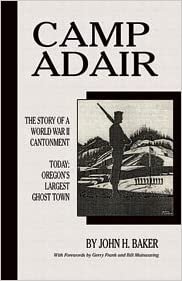By Cathy Ingalls, Albany Regional Museum board member
It was 1940 and although the attack on Pearl Harbor was months away, the government already was looking for potential military training locations, expecting that the United States would eventually be drawn into a war in Europe and in the South Pacific.
Rumors circulated about one of those sites being about six miles north of Corvallis along Highway 99W. That information gave the farmers and townspeople of the small community of Wells the jitters.
The Army needed up to about 65,000 acres for a base, which meant that land would have to be confiscated and residents forced to move. And that’s exactly what happened.
Although an area near Eugene was under consideration, the location soon to be called Camp Adair was selected.
This site was the town of Wells in Benton County, Oregon, one of several which were affected by the development of Camp Adair in 1942. The sign on the barn reads, "M. Senders & Company, Grain Storage". Salem Public Library Historic Photograph Collections, Salem Public Library, Salem, Oregon photo id 8104
The decision to build Camp Adair was made by July 1941 but after Dec. 7, 1941, funding for the base was allocated and residents realized what had been a rumor was now a reality.
Officials began sending letters and knocking on doors letting residents and farmers know that they would be paid for their property, crops and livestock and that they would need to find other places to live.
Farmers renting land were evicted often before they could harvest their crops.
Ten cemeteries were relocated, and the town of Wells was razed within a week.
What follows are some of the recollections of those that were affected by their displacement:
Carl and Beatrice DeArmond. They hosted a large community farewell barbecue. The event was attended by Gov. Charles Sprague and other dignitaries.
Ray and Millie Adams: Many people needed help moving so the Adamses earned extra money by transporting families and belongings to the coast and to southern Oregon.
Ella Gates Molsen: An “arrogant” military official in charge at the time gave orders to the Molsens to leave their property by April 15, 1942, “and not to come back again. This was ordered before any payment on the property was made. The actual check didn’t come until the middle of June.”
She said lots of work had to be done in the six weeks between when the family was told to leave their property and when they had to be gone, including finding a place to move their livestock, machinery and other belongings.
“For me and our family, it was distressing because the community that we grew up in and that used to thrive was no more,” Molsen said.
Neighbors were scattered everywhere and so many people didn’t know where their friends had gone.
Dorice Williams Stewart: Her family had lived on their land since 1846. “The summer of 1942 was a sad one in some ways. Most all of our neighbors were gone. It was a lonely feeling to be the only ones left in our immediate neighborhood.”
Later, the family’s cows, horses and chickens were sold and Dorice’s father bought a 15-acre peach orchard on River Road between Albany and Corvallis.
One upsetting event for Dorice was that she had to transfer from a school in Airlie to Corvallis High School.
Margaret Rutschman Withee: Her family was notified in July 1942 that they would have to leave their farm. She recalls a man from the government telling her parents “because they had received such a small amount for the farm they could consider it as their contribution to the war and they would not need to feel it was their duty to buy war bonds.”
Jean Jones Behrends: Her family that included 11 children had lived on their 464-acre farm for 26 years. They had cleared the trees and pulled out the stumps in order to plant their fields with corn, wheat, oats and hay to feed the cows, horses, sheep and goats.
A postcard arrived at their home on July 1, 1942, stating, “This farm will be vacated by Oct. 1, 1942.”
Luckily, the family found a place to live on a 30-acre farm 40 miles away.
Near the end of World War II, the government declared that much of the land west of Highway 99W was to be made available for sale. A year later, policies were in place explaining how property could be purchased.
Some people did buy their land back, however many did not as they had restarted lives in other places, while others said it was too painful to return to their former home sites.
Officially, Camp Adair closed in the summer of 1944. However, German and Italian prisoners of war were moved to the camp and remained there until May 1946.
Available for purchase at the Albany Regional Museum
Information for this story was taken from “Camp Adair Memories Volume 2” compiled and published by the Polk County Historical Society; “Camp Adair: The Story of a World War II Cantonment: Today Oregon’s Largest Ghost Town,” by John H Baker; and “Gem of the Willamette Valley A History of Albany, Oregon” by Edward Loy.
The two books are for sale at the Albany Regional Museum and the volume of memories along with other materials about Camp Adair can be found in the museum’s reference room.
Beginning in June the Museum’s hours will be Tues-Fri 11 - 4, Saturday’s 10 - 2.
The museum is located at 136 Lyon St. S.
For more information, call 541-967-7122 or email, info@armuseum.com.


